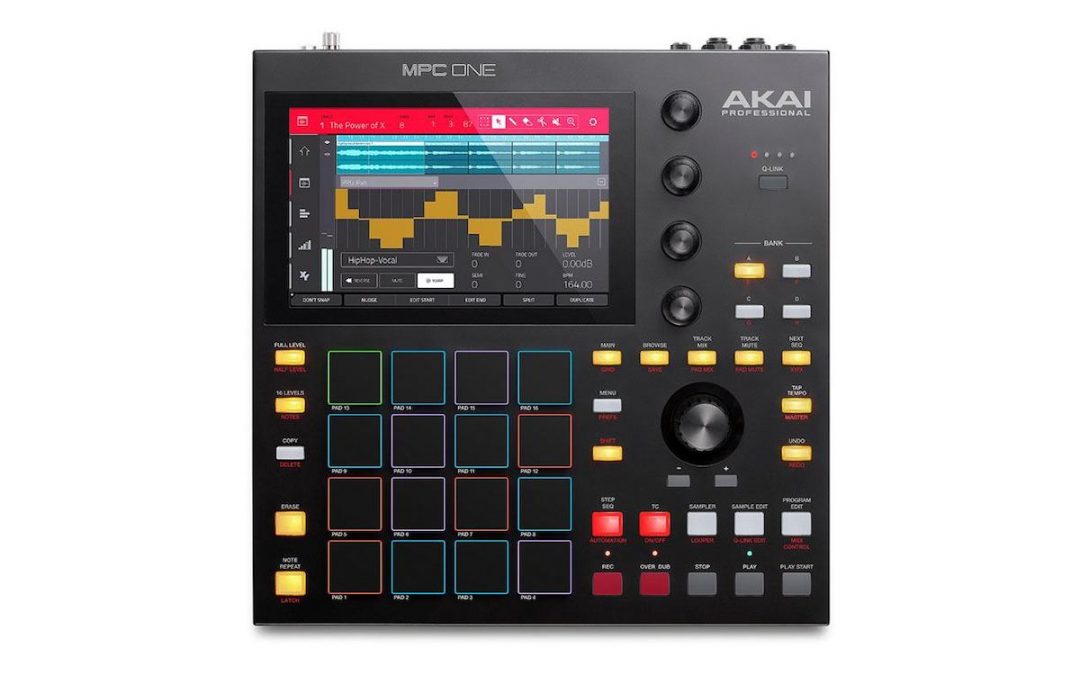Akai Professional’s long-running MPC series is one of the most recognized sampling workstations ever made. Originally named MIDI Production Center (now Music Production Center), Akai introduced the first model, the MPC60, in 1988. Roger Linn, who developed the popular LM-1 drum machine in 1980, designed the earliest MPCs. Renowned for their influence on hip hop and electronic music, today’s workstations share DNA with their predecessors, with upgrades suited for modern digital recording. In this MPC One review, we’ll break down Akai’s affordable sequencer and sampling workstation.
Akai MPC One Overview
The Akai MPC One is sort of a hybrid between Akai’s very popular MPC Live and X units. It’s a cheaper alternative to both, but by no means sacrifices functionality for affordability. Even though the MPC One sits at the lowest price point, the whole MPC series doesn’t necessarily conform to the ‘good, better, best’ model. Instead, each workstation serves a different set of needs which is reflected in the price—in that way, cost is not indicative of quality.
For the series, the MPC X serves as a studio centerpiece and weighs in at a hefty $2299. It’s followed by the portable MPC Live which sets you back a cool $1299. Finally, the MPC One enters at $799; overall, it’s a reasonable way to enter the world of standalone production units.
The MPC One is actually smaller and lighter than the Live, but packs in more dedicated function buttons akin to the X. Naturally, all of the core MPC functions are present, though Akai has made understandable concessions. For example, audio I/O is just standard stereo, the unit does not have WiFi or Bluetooth, storage options are more restrictive, and there’s no internal battery like the Live.
Features
The latest generation MPCs are standalone multitrack production stations. You can play loops, trigger drum samples and sample-based instruments, and sequence it all together for complete electronic music production in a single device. No MPC One review would be complete without a list of features, of course, courtesy of Akai:
- Standalone MPC – No Computer Required
- Powerful Multicore System from the MPC Live II and MPC X
- 16 Velocity Sensitive RGB Pads
- Brilliant 7″ Multi-Touch Display
- 2 GB RAM, 2GB Onboard Storage, 2GB pre-installed content
- Mac & PC Controller for MPC Software (included)
- Stereo Line Level Inputs
- MIDI In & MIDI Out
- 4 TRS CV/Gate Jacks, 8 Outputs Total
- USB 2.0 Slot for Storage Drives or Midi Controllers for use in Standalone
- SD Card Slot
Overall, the MPC One contains most of the powerful functionality you’d find in the more feature-rich models. It contains all 16 pads in iconic MPC fashion; they’re just a bit smaller than usual so Akai could also squeeze in the 7″ touch screen, which is an integral part of the device’s workflow.
MPC One vs MPC Live II
While there are plenty of differences between the MPC One and the MPC Live II, it’s important to note that both run the exact same operating system and share the same CPU and RAM. That is to say that the computing power is identical between the two.
Physically, the MPC One is actually a bit smaller and lighter than the Live II, despite the latter coming as a portable unit first. The MPC Live II can run on a rechargeable battery for true portability and on-the-go music production, while the MPC One ditched the battery to reduce cost.
They both have 4 Q-Link knobs and 16 pads; the Live II’s pads are full size, whereas the One’s are shrunk down a bit. The MPC One actually has four more function buttons than the Live II with 31. Things like WiFi and Bluetooth are missing from the MPC One, which isn’t a total dealbreaker but is useful for syncing the Live II to your Splice library, for instance. The MPC One also does not support direct USB file transfer to a computer, and comes with only 2GB of onboard storage compared to the Live II’s 16GB.
The MPC Live II also has expanded I/O, though the MPC One’s options are quite adequate for most normal users.
MPC One Review: Conclusion
Overall, the MPC One is an excellent introduction to standalone sampling and sequencing. As far as an affordable entry in the MPC line goes, it delivers on all fronts, and fortunately does not sacrifice essential functionality to cut cost. Whether you’re a seasoned producer or a beginner, the MPC One is a fantastic tool.
